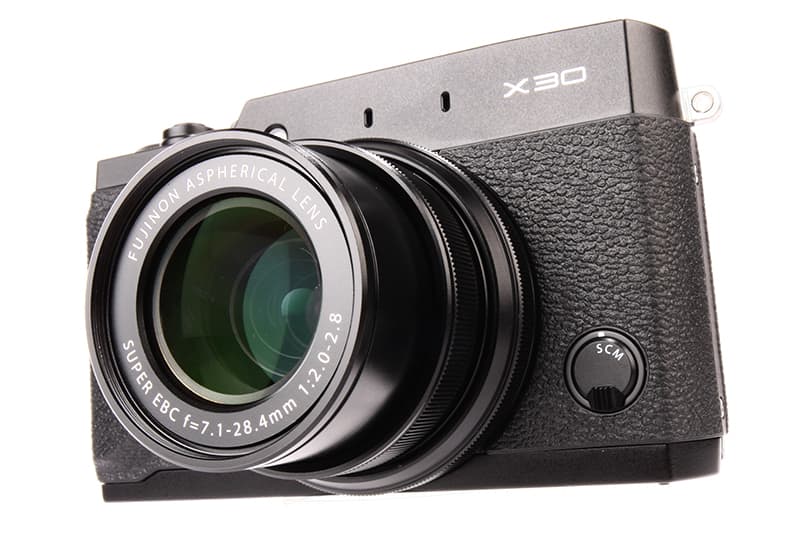Fujifilm’s X-series compacts share the same aesthetic values to their compact system camera counterparts and remain an attractive proposition for those after a classic and stylish model that provides all the manual control one could ask for.
At first glance, Fujifilm’s third premium compact – the X30 – looks similar to what we’ve seen before, and while that’s no bad thing, it enters a competitive market that’s thriving with new models and technology.
This begs the question: can it bring enough new features to the table to be a serious contender up against three of its rivals – the Canon PowerShot G7X, Panasonic Lumix LX100 and Sony CyberShot RX100 III?
Fujifilm X30 Review – Features
A quick look over the spec sheet reveals many of the X30’s innards are identical to the X20. The same can be said for the lens, which covers a focal length of 28-112mm with a variable aperture of f/2-2.8.
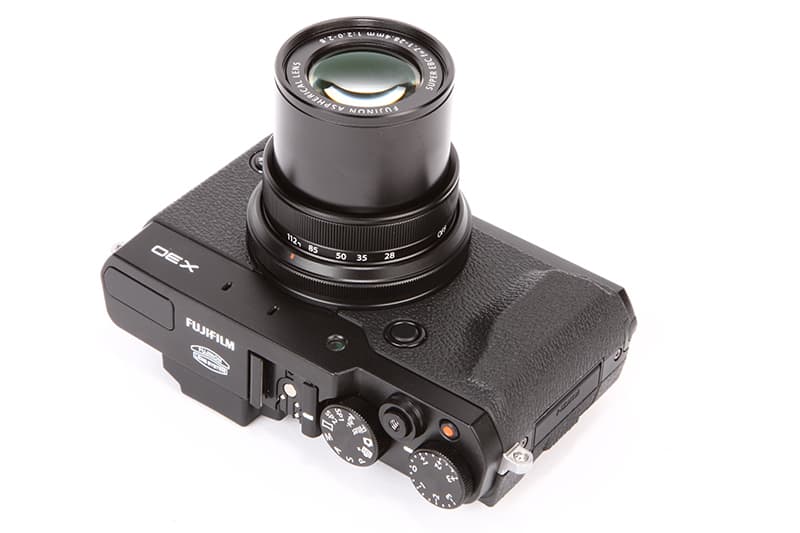 Behind this lens lies the same 12MP 2/3inch-type X-Trans CMOS II sensor as used in the X20, which features its own unique colour filter array that makes the use of an anti-aliasing filter redundant to effectively boost the level of detailed captured, while reducing traces of moiré patterning.
Behind this lens lies the same 12MP 2/3inch-type X-Trans CMOS II sensor as used in the X20, which features its own unique colour filter array that makes the use of an anti-aliasing filter redundant to effectively boost the level of detailed captured, while reducing traces of moiré patterning.
With the same sensor and same lens present, it’s perhaps no surprise that the X30 also inherits the X20’s EXR Processor II, which permits an impressive continuous shooting burst of 12fps, full HD, 1920×1080-pixel movie recording at a variety of frame rates that includes, 60, 50, 20, 25 and 24fps, as well as a near-instant startup time of 0.5secs.
With so many key similarities to what has already been seen before, I hear you asking the question; so what is new?
Though the technology on the inside is essentially the same Fujifilm’s engineers have spent their efforts refining the exterior, with its standout feature being a new 0.39inch, 2.36-million-dot OLED electronic viewfinder that replaces the optical viewfinder from before.
With a 100% viewing coverage, 0.65x magnification and display lag time of 0.005secs, the viewfinder is up there as the best in its class, superior in resolution terms to the pop-up EVF as found on the Sony RX100 III and less tunnel like and more pleasing to use than the EVF present on the Panasonic Lumix LX100.
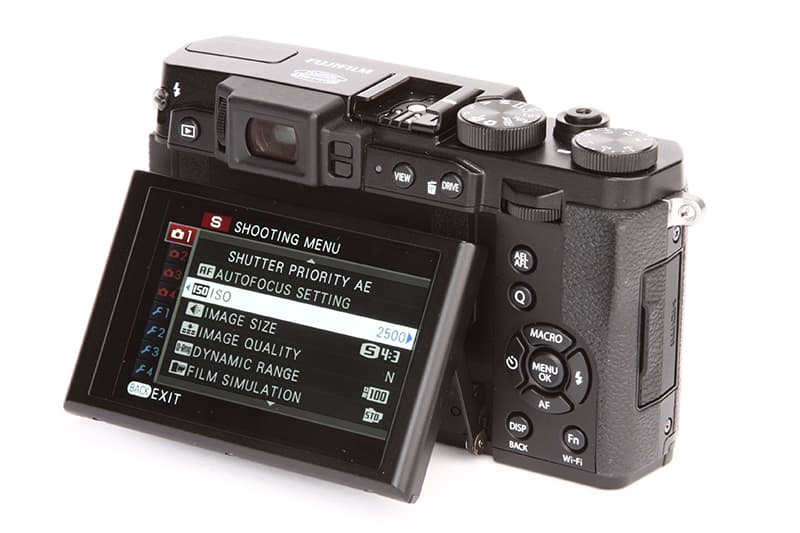 The compositional benefits don’t end here and to keep up with the Sony RX100 III and Canon G7 X, the X30 introduces a larger 3.0inch, 920k-dot screen at the rear that can be tilted upward by just over 90 degrees and downward by 45 degrees for easy shooting at extreme angles.
The compositional benefits don’t end here and to keep up with the Sony RX100 III and Canon G7 X, the X30 introduces a larger 3.0inch, 920k-dot screen at the rear that can be tilted upward by just over 90 degrees and downward by 45 degrees for easy shooting at extreme angles.
Although touch functionality isn’t catered for, the screen is a leap in the right direction and a significant improvement on the X20’s rather lacklustre 460k-dot LCD panel that was criticized last year.
Viewfinder and screen aside, other improvements to the X30 include an external 2.5mm mic input, a wired remote input and the addition of Wi-Fi, opening up the opportunity to control the camera wirelessly or download photos instantly to an iOS or Android smartphone or tablet running Fujifilm’s Camera Remote app.
With Wi-Fi being notorious for draining battery life, Fujifilm has upped the ante with regard to battery stamina. The X30 is now capable of shooting 470 shots on a single charge – a 200 shot improvement over the X20 according to CIPA’s recognized test procedure.
Build and Handling
Fujififlm X30 Review – Build and Handling
The X30, to all intents and purposes, feels as solid and robust as the manufacturers CSCs in terms of its build quality, and if it’s anything like the X-E2 that I’ve battered and bruised, it’ll happily survive the test of time and the occasional knock along the way. The only downside to its muscular build is that it is quite heavy. Weighing 383g, it’s equivalent to around 100g heavier than its closest Canon and Sony rivals.
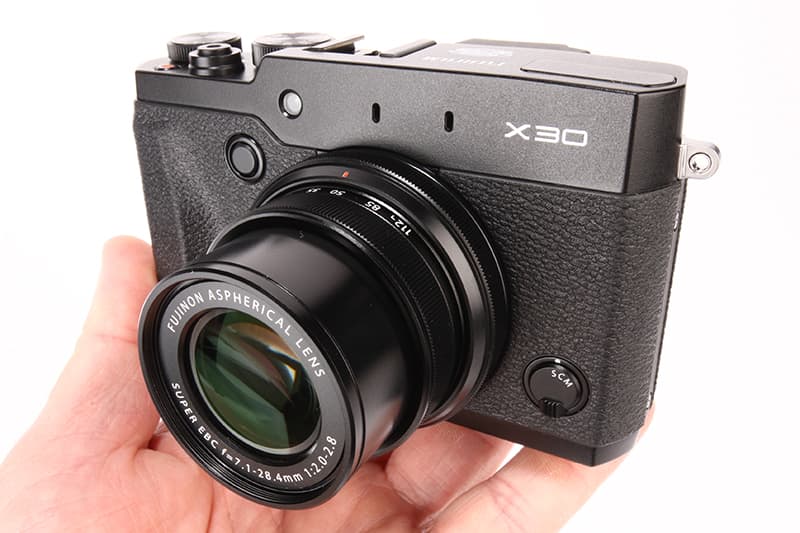 The rubberised grip gives it a highly tactile feel, but if I was to be picky, I would have liked to see this stretch all the way around the left side of the body where there’s a mismatch (albeit a subtle one) between the texture of the rubber and imitation plastic.
The rubberised grip gives it a highly tactile feel, but if I was to be picky, I would have liked to see this stretch all the way around the left side of the body where there’s a mismatch (albeit a subtle one) between the texture of the rubber and imitation plastic.
Metal dials and a threaded shutter button for the attachment of a wire cable release are carried across from the X20’s top plate, however there’s a small movie-rec button added in front of the exposure compensation dial, which itself is no longer recessed into the body and stands proud just like the mode dial.
Revisions to button placement are also found at the rear where the larger screen sees the playback button positioned beside the viewfinder’s dioptre dial, while buttons to the right of the screen take up a similar arrangement to the company’s X-E2.
At the front corner of the body there’s a switch to instantly toggle between single, continuous and manual focusing modes, and just to the side of where the index finger lays to rest at the front of the grip is another button that allows users assign a function to the all-new control ring that’s positioned behind the zoom ring.Though fairly thin it remains easy to access from behind the camera and is by far the best handling improvement.
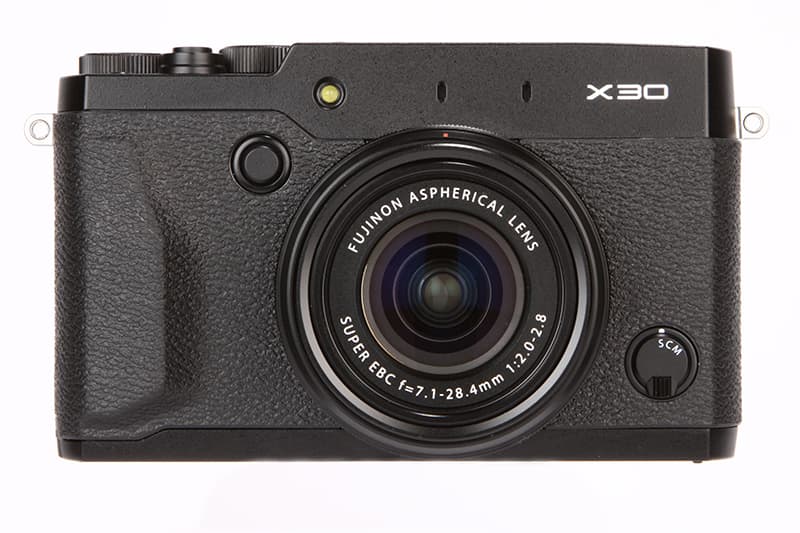 Being customisable, it allows users to take instant control of white balance, ISO, film simulation modes, or continuous shooting from a simple twist of the ring, plus it doesn’t notch or click into place meaning it won’t interrupt you when you’re adjusting aperture or shutter speed, or recording HD video.
Being customisable, it allows users to take instant control of white balance, ISO, film simulation modes, or continuous shooting from a simple twist of the ring, plus it doesn’t notch or click into place meaning it won’t interrupt you when you’re adjusting aperture or shutter speed, or recording HD video.
As for the zoom ring, this doubles up as the X30’s on/off switch. Extend the zoom past the off setting on the lens barrel and the camera instantly powers up ready to shoot, with the manual zoom ring offering a satisfyingly smooth and fluid movement across its range.
There’s a good level of resistance when you reach the wide end to prevent turning off the camera accidentally, and Fujifilm’s idea of lining the inside of the lens cap with felt means that even if the cap gets knocked, it refuses to engage the lens, thus helping to preserve battery life and prevent lens damage.
Performance
Fujifilm X30 Review – Performance
 The X30 excels itself at the speed in which it can focus in single-AF mode, which is claimed to offer an acquisition speed of 0.06secs. It rarely struggles to lock onto subjects quickly and focusing speed was only fractionally slower at the telephoto end of the zoom compared with wide-angle. The X30’s bright AF assist beam is on hand should you require extra illumination in low light, but even with this switched off, I was extremely impressed with how well the camera recognized subjects devoid of detail and focused quickly on scenes lacking contrast.
The X30 excels itself at the speed in which it can focus in single-AF mode, which is claimed to offer an acquisition speed of 0.06secs. It rarely struggles to lock onto subjects quickly and focusing speed was only fractionally slower at the telephoto end of the zoom compared with wide-angle. The X30’s bright AF assist beam is on hand should you require extra illumination in low light, but even with this switched off, I was extremely impressed with how well the camera recognized subjects devoid of detail and focused quickly on scenes lacking contrast.
Some shifting of the lens was experienced in continuous AF at both wide angle and full telephoto, but the way the X30 offers fast access to reposition the AF point, combined with the option to bring up a magnified view on screen by depressing the scroll dial at the rear, in all provides a intuitive way to control autofocus quickly and effectively.
 With a good number of physical controls on the body and all the main camera settings you need available from the X30’s quick menu, it’s a camera that’s very simple to setup and use. The performance of the X30’s electronic viewfinder is most impressive however. The eye sensor switches the feed automatically between the screen and the EVF in less than a second, while the view through the viewfinder is bright and clear. Most importantly, it’s superb at rendering fine detail and displaying clear shooting information.
With a good number of physical controls on the body and all the main camera settings you need available from the X30’s quick menu, it’s a camera that’s very simple to setup and use. The performance of the X30’s electronic viewfinder is most impressive however. The eye sensor switches the feed automatically between the screen and the EVF in less than a second, while the view through the viewfinder is bright and clear. Most importantly, it’s superb at rendering fine detail and displaying clear shooting information.
With the viewfinder being as good as it is, I found myself composing virtually all my images using it, other than the times when the camera was held at low or high angles where the tilting screen proved its worth.
 Putting the X30’s continuous shooting to the test, we managed to record 18 Fine JPEGs in its Super High (12fps) burst mode. Switching the mode across to High allowed us to record Raw & JPEGs simultaneously at a maximum speed of 9fps, with 12 files being recorded before the X30’s buffer kicked in and prevented any more to be taken. By compact camera terms, the X30 puts in a very respectable performance in all the key criteria a great camera must excel.
Putting the X30’s continuous shooting to the test, we managed to record 18 Fine JPEGs in its Super High (12fps) burst mode. Switching the mode across to High allowed us to record Raw & JPEGs simultaneously at a maximum speed of 9fps, with 12 files being recorded before the X30’s buffer kicked in and prevented any more to be taken. By compact camera terms, the X30 puts in a very respectable performance in all the key criteria a great camera must excel.
The X30 also allows users to view images in playback mode without having to turn the camera on by physically extending the zoom. This is achieved by holding the playback button for three seconds, after which the last image taken will reveal onscreen. A simple tap of the playback button again shuts down the camera to prevent the X30 using up unnecessary battery power. It’s a useful shortcut to know and one that was used frequently out in the field while we were testing the camera.

Image Quality
Fujifilm X30 Review – Image Quality
Resolution
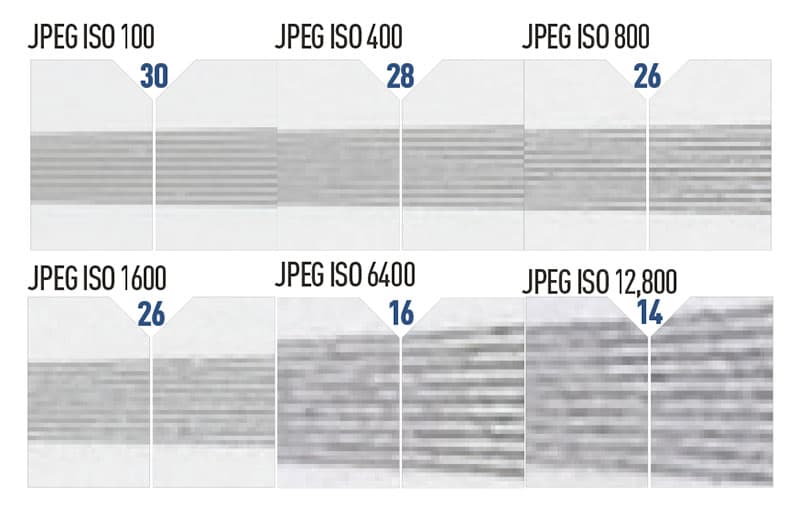 A close inspection of our resolution chart revealed the X30’s Raw files resolve 3000 l/ph at ISO 100, which drops off to around 2600 l/ph at ISO 1600 and 2400 l/ph at ISO 3200. Beyond this sensitivity, the X30 only shoots JPEGS, however this remains a strong performance from a 12MP 2/3inch-type sensor and puts it on par with the results recorded by the X20.
A close inspection of our resolution chart revealed the X30’s Raw files resolve 3000 l/ph at ISO 100, which drops off to around 2600 l/ph at ISO 1600 and 2400 l/ph at ISO 3200. Beyond this sensitivity, the X30 only shoots JPEGS, however this remains a strong performance from a 12MP 2/3inch-type sensor and puts it on par with the results recorded by the X20.
Dynamic Range
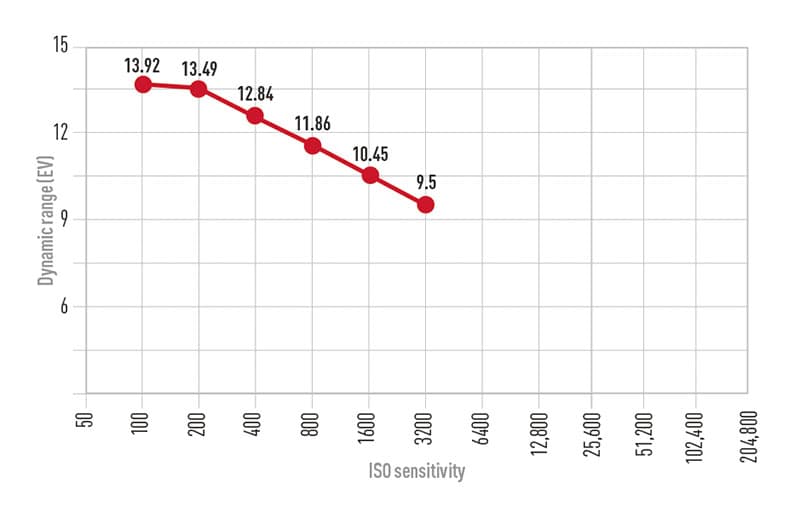 Due to the fact the X30 only records Raw files between ISO 100-3200, our dynamic range results aren’t quite as widespread on the chart as some of its rivals. At ISO 100, the peak dynamic range is a high 13.92EV, which reduces to 9.5EV at ISO 3200. The X30’s D-Range Optimiser helped to balance exposures in high-contrast conditions, but even with this switched off, it was possible to return a high level of detail to shadows and highlights using Camera Raw.
Due to the fact the X30 only records Raw files between ISO 100-3200, our dynamic range results aren’t quite as widespread on the chart as some of its rivals. At ISO 100, the peak dynamic range is a high 13.92EV, which reduces to 9.5EV at ISO 3200. The X30’s D-Range Optimiser helped to balance exposures in high-contrast conditions, but even with this switched off, it was possible to return a high level of detail to shadows and highlights using Camera Raw.
Noise
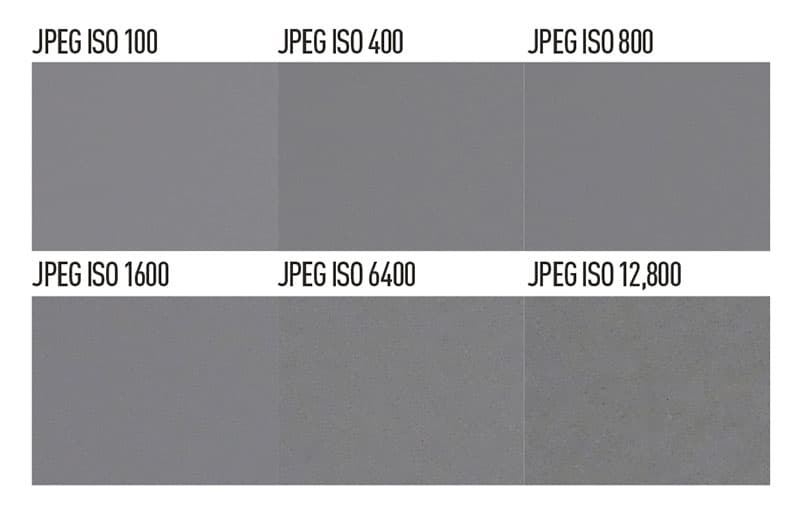 The X30 produces noise-free images at low sensitivity settings, with the first traces of luminance noise creeping in at ISO 400. Although noise is removed reasonably well between ISO 400-800 in JPEG files, fine detail at higher ISOs is lost in the JPEG smoothing process, so as a rule of thumb, it’s always advisable to shoot Raw for the ultimate quality. ISO 6400 and 12,800 should only be used in emergencies.
The X30 produces noise-free images at low sensitivity settings, with the first traces of luminance noise creeping in at ISO 400. Although noise is removed reasonably well between ISO 400-800 in JPEG files, fine detail at higher ISOs is lost in the JPEG smoothing process, so as a rule of thumb, it’s always advisable to shoot Raw for the ultimate quality. ISO 6400 and 12,800 should only be used in emergencies.
Verdict
Fujifilm X30 Review – Verdict
 Though the X30 is lagging behind some premium compacts with regard to its output resolution and sensor size, it’s a respectable improvement over the X20 and has been designed in a way that it provides a thoroughly enjoyable handling and operational experience.
Though the X30 is lagging behind some premium compacts with regard to its output resolution and sensor size, it’s a respectable improvement over the X20 and has been designed in a way that it provides a thoroughly enjoyable handling and operational experience.
What the X30 really excels at is bringing a premium build quality and an attractive array of features together at a price that’s considerably less than its rivals. Its smaller sensor is likely to have its work cut out to resolve quite the same level of detail and perform, as well under low light conditions compared to its key opponents – something we plan to find out in a forthcoming group test up against the Canon G7 X, Sony RX100 III and Panasonic Lumix LX100, however its image quality will more than satisfy those working to tighter budget restraints.
As for photographers who’d prefer the thought of lifting the camera to their eye as opposed to looking at an LCD screen, simply put, there’s no compact camera out there right now with a better electronic viewfinder. Add the rapid autofocus speed, top-notch all-round performance and sensational build quality to the mix and it goes without saying, the X30 is up there as one of the best premium compacts you can buy for under £500.
First Look
Fujifilm X30: Features
Building on the popular Fujifilm X20, the new Fujifilm X30 is the third generation X series camera to be released by the Japanese firm.
A brand new electronic viewfinder – replacing the optical version on its predecessors – delivers a close to real-time view of the frame thanks to its 2.36-million-dot screen, 55 frames-per-second refresh rate and essentially non-existent lag time of 0.005sec.
It’s the largest and fastest electronic viewfinder in its camera class and can be set to a live view mode that reproduces the experience of using an optical viewfinder with the added benefit of displaying shooting information and manual focusing magnification.
Instead of overhauling the core technology in the previous model, Fuji has instead sought to get more out of the same 12-million-pixel 2/3-inch X-Trans CMOS II sensor and EXR Processor II that were used in the X20. Like the X20, it also omits an optical low-pass filter.
The result is a more efficient camera that also sees the introduction of some features that pay homage to the firm’s heritage, as well as advancing the model’s video recording capabilities.
Battery performance has also been improved with the addition of a larger capacity NP-95 cell, similar to that featured in the X100. The larger battery will also benefit from some power management improvements that sees the X30 deliver up to 450 frames, that’s 1.8 times more shots on a single charge than its predecessor.
One of the most attractive new features that come with this camera is the addition of Classic Chrome film simulation mode, which aims to reproduce warm skin tones, vivid blue skies and rich green trees. It’s a welcome nod to Fujifilm’s 80-year heritage in photographic film and colour reproduction.
Elsewhere on the new camera there’s the much-touted world’s fastest high-speed AF, which uses phase detection to deliver focus acquisition in just 0.06sec. The camera is able to detect subject and scene conditions and switch to contrast AF when appropriate.
Elsewhere, with a startup time of 0.5sec, a shutter time lag of 0.01sec and shooting interval of 0.3sec, speed is very much the name of the game. Top of the list is high-speed continuous shooting of 12fps.
Fujifilm X30: Build and Feel
Side by side the Fujifilm X30 is slightly larger than the previous model, and cuts noticeably chunkier profile. However in the hand it feels sturdy and well made. Available in both black and silver this classically styled camera looks and feels every bit the premium compact that Fuji intended it to be.
This time around Fuji has opted for a tiltable 3-inch 920K-dot premium clear LCD screen that can be positioned for easier shooting at extreme angles.
The camera’s f/2 to f/2.8 fixed lens has a focal range of 28 to 112mm and features an optical 4x manual zoom and a control ring positioned along the same axis, making it easy to make adjustments to aperture settings and shutter speed whilst composing with manual zoom. The button layout on the rear of the camera has been shifted around from the previous model to incorporate the tilting screen, and slightly resembles the configuration of the XE2.
Fujifilm X30: First Impressions
Fuji attracted a lot of attention with the X20 and is looking to bolster its position in the premium compact camera market with the new X30. Some may look at it on paper and say that not much has changed, however the updates set this camera apart from the competition in a number of attractive ways.
It’s the only compact camera with a dedicated mechanical zoom ring, it’s one of very few compacts with a high quality EVF built-in, its broad lens range of 28-112mm reaches further than that of Sony’s RX100 III. And its high-speed auto-focusing is second to none.
Priced competitively at £479, this camera will undoubtedly attract the attention of enthusiast photographers keen to have manual control in a compact body, either as a second body or as a considerable step up from a more basic compact camera.

